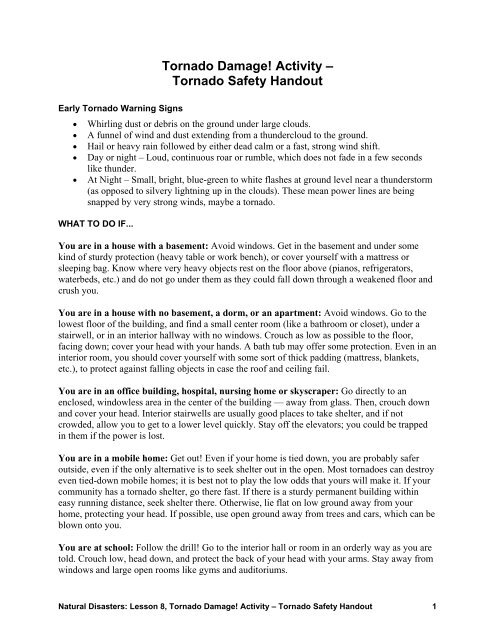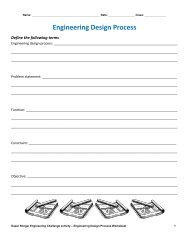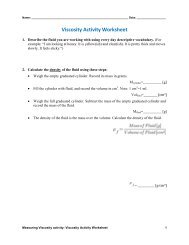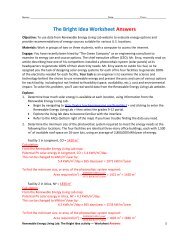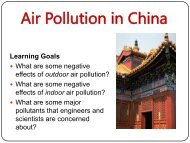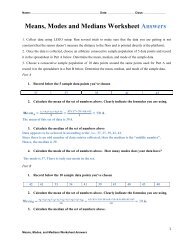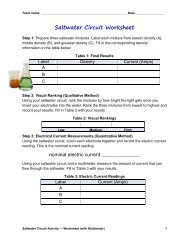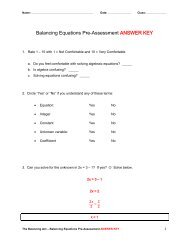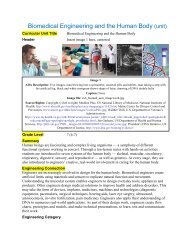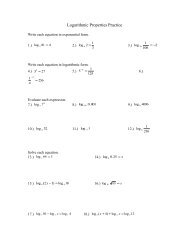Tornado Safety Handout - Teach Engineering
Tornado Safety Handout - Teach Engineering
Tornado Safety Handout - Teach Engineering
You also want an ePaper? Increase the reach of your titles
YUMPU automatically turns print PDFs into web optimized ePapers that Google loves.
<strong>Tornado</strong> Damage! Activity –<br />
<strong>Tornado</strong> <strong>Safety</strong> <strong>Handout</strong><br />
Early <strong>Tornado</strong> Warning Signs<br />
• Whirling dust or debris on the ground under large clouds.<br />
• A funnel of wind and dust extending from a thundercloud to the ground.<br />
• Hail or heavy rain followed by either dead calm or a fast, strong wind shift.<br />
• Day or night – Loud, continuous roar or rumble, which does not fade in a few seconds<br />
like thunder.<br />
• At Night – Small, bright, blue-green to white flashes at ground level near a thunderstorm<br />
(as opposed to silvery lightning up in the clouds). These mean power lines are being<br />
snapped by very strong winds, maybe a tornado.<br />
WHAT TO DO IF...<br />
You are in a house with a basement: Avoid windows. Get in the basement and under some<br />
kind of sturdy protection (heavy table or work bench), or cover yourself with a mattress or<br />
sleeping bag. Know where very heavy objects rest on the floor above (pianos, refrigerators,<br />
waterbeds, etc.) and do not go under them as they could fall down through a weakened floor and<br />
crush you.<br />
You are in a house with no basement, a dorm, or an apartment: Avoid windows. Go to the<br />
lowest floor of the building, and find a small center room (like a bathroom or closet), under a<br />
stairwell, or in an interior hallway with no windows. Crouch as low as possible to the floor,<br />
facing down; cover your head with your hands. A bath tub may offer some protection. Even in an<br />
interior room, you should cover yourself with some sort of thick padding (mattress, blankets,<br />
etc.), to protect against falling objects in case the roof and ceiling fail.<br />
You are in an office building, hospital, nursing home or skyscraper: Go directly to an<br />
enclosed, windowless area in the center of the building — away from glass. Then, crouch down<br />
and cover your head. Interior stairwells are usually good places to take shelter, and if not<br />
crowded, allow you to get to a lower level quickly. Stay off the elevators; you could be trapped<br />
in them if the power is lost.<br />
You are in a mobile home: Get out! Even if your home is tied down, you are probably safer<br />
outside, even if the only alternative is to seek shelter out in the open. Most tornadoes can destroy<br />
even tied-down mobile homes; it is best not to play the low odds that yours will make it. If your<br />
community has a tornado shelter, go there fast. If there is a sturdy permanent building within<br />
easy running distance, seek shelter there. Otherwise, lie flat on low ground away from your<br />
home, protecting your head. If possible, use open ground away from trees and cars, which can be<br />
blown onto you.<br />
You are at school: Follow the drill! Go to the interior hall or room in an orderly way as you are<br />
told. Crouch low, head down, and protect the back of your head with your arms. Stay away from<br />
windows and large open rooms like gyms and auditoriums.<br />
Natural Disasters: Lesson 8, <strong>Tornado</strong> Damage! Activity – <strong>Tornado</strong> <strong>Safety</strong> <strong>Handout</strong> 1
You are in a car or truck: Vehicles are extremely dangerous in a tornado. If the tornado is<br />
visible, far away, and the traffic is light, you may be able to drive out of its path by moving at<br />
right angles to the tornado. Otherwise, park the car as quickly and safely as possible — out of the<br />
traffic lanes. Get out and seek shelter in a sturdy building. If in the open country, run to low<br />
ground, away from any cars (which may roll over on you). Lie flat and face-down, protecting the<br />
back of your head with your arms. Avoid seeking shelter under bridges, which can create deadly<br />
traffic hazards while offering little protection against flying debris.<br />
You are in the open outdoors: If possible, seek shelter in a sturdy building. If not, lie flat and<br />
face-down on low ground, protecting the back of your head with your arms. Get as far away<br />
from trees and cars as you can; they may be blown onto you in a tornado.<br />
You are in a shopping mall or large store: Do not panic. Watch for others. Move as quickly as<br />
possible to an interior bathroom, storage room or other small enclosed area, away from windows.<br />
Crouch face-down and protect your head with your arms.<br />
You are in a church or theater: Do not panic. If possible, move quickly but orderly to an<br />
interior bathroom or hallway, away from windows. Crouch face-down and protect your head<br />
with your arms. If there is no time to do that, get under the seats or pews, protecting your head<br />
with your arms or hands.<br />
AFTER THE TORNADO...<br />
Keep your family together and wait for emergency personnel to arrive. Stay away from power<br />
lines and puddles with wires in them; they may still be carrying electricity! Watch your step to<br />
avoid broken glass, nails, and other sharp objects. Stay out of any heavily damaged houses or<br />
buildings; they could collapse at any time. Do not use matches or lighters, in case of leaking<br />
natural gas pipes or fuel tanks nearby. Remain calm and alert, and listen for information and<br />
instructions from emergency crews or local officials.<br />
Source: http://www.spc.noaa.gov/faq/tornado/safety.html<br />
Natural Disasters: Lesson 8, <strong>Tornado</strong> Damage! Activity – <strong>Tornado</strong> <strong>Safety</strong> <strong>Handout</strong> 2


